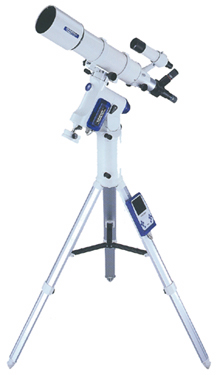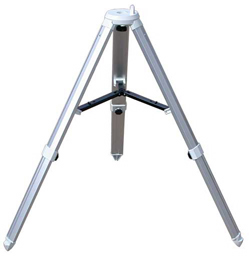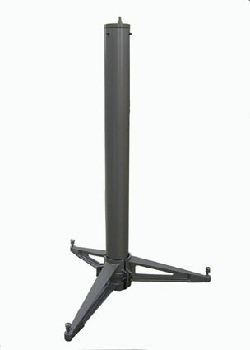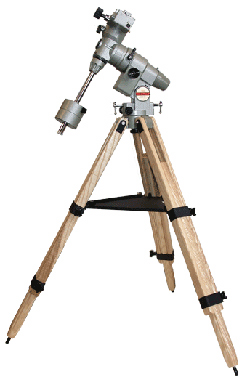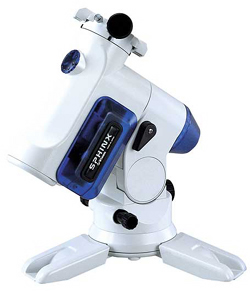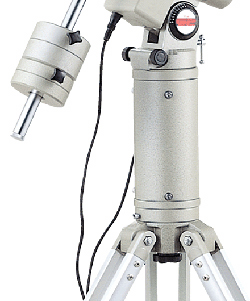Vixen Distribution
![]() History
History ![]() News
News ![]() Notes & Literature
Notes & Literature ![]() Overview
Overview ![]() Pricing
Pricing ![]() Products
Products
![]() Mounts
Mounts
![]() Telescopes
Telescopes
![]() Quality Control
Quality Control
![]() Service or Repair
Service or Repair

VIXEN TRIPODS, PIERS, AND RELATED ITEMS
"a mount is only as good as what it rests upon..."
Right: Vixen 102 ED "SS" 4 inch Apo with SPHINX SXW German equatorial mount which includes STAR BOOK,
SX-HAL110 aluminum Field Tripod, and SX Half Pier (30,171 bytes)
Click on the image to see enlarged view (51,922 bytes).
By the 21st century we have come some distance improving equatorial heads and their platforms, this is in part due to better materials and alloys but also to computer aided design which can ameliorate resonance's, and other undesirable characteristics. These improvements in design are in part what make the Vixen series of German equatorial mounts so lightweight and competitive.
The equatorial mount head determines much about how the telescope or other attached payload may be used, but the design and materials used in the tripod or pier will in good measure determine:
- how long and heavy the payload can be on the Mount Head
- how quickly all will dampen if disturbed (by touching the telescope, by wind gusts, etc.)
- the orientation and overall comfort of the observer
- ease of how the stand will be set up
- how easy it will be to pack and transport the stand
The choices of stands offered by Vixen are:
- Aluminum Tripod: adjustable height and models of varying rigidity and cost
- Wood Tripod: adjustable height with good rigidity and a fair cost
- Tabletop Tripod: fixed height with good rigidity and excellent portability
- Portable Pier: fixed height with good rigidity and somewhat higher cost
Raw Materials and Arrangement: Vixen tripods are the best in their class (kg per kg) in terms of rigidity, resistance to lateral flexure, and dampening. Tripod hinges and clamps, and the platform upon which a mount head will rest are generally made of cast metal alloys ground to precise tolerances processed through numerous quality control steps. The pins, hinges and clamps provided by Vixen are among the more precise that can be found in tripods of this price. The Vixen tripods legs are extending designs made of aluminum or wood. There are ultra lightweight Carbon Fiber tripods on the horizon, but presently these are very costly when scaled to manage the requirements of a telescope system.
The Vixen tripod are two section extension designs, these are too long to carry onto an airliner for example, but are quite easily managed by most people. The advantages of an extending tripod are: 1. the height can be adjusted to suit the operators preference, 2. retracting the legs facilitates transport, and 3. being able to adjust the height means one can very nearly level a German mount head during set up and thereby minimize the need to make changes of elevation to the head to attain Pole Alignment.
Generally speaking hard wood tripods tend to do a better job than aluminum at dealing with vibrations and resonance's. The wood will absorb much of these while an aluminum tripod may resonate, transmitting these back and forth for notably longer times than the wood alternative. There is also the aesthetic appeal of fine wood work, this is not to be underestimate when one needs approval from a spouse to bring a new telescope home. Appearance is a matter of taste, but few people who compare the look of a good wood tripod to a metal one will if given a choice choose the metal tripod. So why do we not make all tripod of wood? Well first of all a wood tripod may weigh three or more times more than a similarly rigid tripod made of alloys. Wood is more likely to require maintenance in the form of cleaning, maybe applying some polish or sun light resistant oil finish. Wood legs can tolerate minor scrapes or dings, but they may split (as aluminum may buckle) or suffer other catastrophic failure if it handled recklessly. Wood legs will contract in response to drops of temperature, so one will have to periodically tighten leg clamps if the temperature drops throughout the night.
Metal tripods tend to hold up better to abuse in transport, and in harsh environments since they are impervious to moisture, sunlight, and resist salt air better. The aluminum tripods made by Vixen in Japan do well in terms of rigidity and resistance to flexure at supporting their designed payloads. Do not hesitate to choose the lightweight aluminum tripod for visual applications where lightweight and transportability are a concern; remember, the best telescope is the one that gets used.
Deciphering the Vixen Tripod Code:
- AL is their abbreviation for Aluminum
- HAL is an abbreviation for Heavier Aluminum for added strength
- the suffix "110" for example on the HAL110 indicates a maximum height of 110 cm
The Vixen HAL110 tripods made for the GP and SPHINX SXW German equatorial mounts are similar in most respects except trim paint. The cast alloy components of the GP tripods are painted in green to match the GP series, these carry the 3xxx series part numbers. While the cast alloy components of tripods painted in a pearl white match the SPHINX SXW series, these carry the 2xxx series part numbers. The same applies for the Half Pier (or Half Pillar), it is available as Part No. 3584 in green for the GP mounts, while the SXW mount unit is Part No. 2516 described as the "SX Half Pillar".
![]() Tripods Specifications, Illustrations
Tripods Specifications, Illustrations
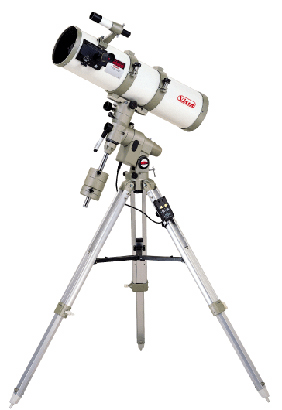
AL90 Aluminum Tripod for GP series Mounts
Extends from 62 cm to 90 cm
AL150 Aluminum Tripod for GP series Mounts
Extends from 24.4 to 59 inches / 93 cm to 150 cm
Right: A complete Vixen
HAL110 Aluminum Tripod for GP-series
Extends from 27.6 to 43.3 inches / 70 cm to 110 cm
SX-HAL110 Aluminum Tripod for SX series
Extends from 27.6 to 43.3 inches / 70 cm to 110 cm
Left: Vixen SX-HAL110 Aluminum Field Tripod in white pearl finish.
Metal Pillar Model P110 GP
A heavy and sturdy fixed height platform for the GP and GP-DX mounts. It is also more likely to place the observer at a more convenient observing positions, and prevents binding the telescope tube against conventional tripod legs when using a longer refracting telescope.
Right: Vixen Metal Pillar P110GP (15,093 bytes).
Vixen Ash Wood Tripod
It has long been a request to provide a rock solid hard wood tripod for the GP and GP-DX mounts and as announced in 2003 - we've got it! This tripod is solid, providing excellent dampening and resistance to flexing. It is also a well made and a handsome piece of furniture to behold.
The two section extension legs are made of Ash, a durable and attractive hard wood used to make Baseball Bats for example. Heavy duty legs are secured to a platform which accepts the Great Polaris mounts. Each two section tripod leg has two tightening clamps to guarantee stability, and a large metal accessory tray is included. Some simple assembly is required however, no tools are needed to assemble it in the field. This is the perfect tripod for any Vixen mount and it can be purchased separately or packaged with a new GP or GP-DX mount.
This is the same wood tripod and provided with the well regarded TeleVue Gibraltar mounts, and it is is the basis for the TeleVue Alt-Az mount for their 5 inch Apo, the 127. Made in the USA.
Solid ash wood legs legs, tray and GP-type mount adapter included.
Left: Vixen Ash Wood Tripod (40,563 bytes).
Company Seven can retrofit your TeleVue Gibraltar Ash or Teak wood tripod to accept the Vixen GP or GPE series heads in Green or White. And as a courtesy to our customers, we also offer a retrofit hardware kit that we can send to you so that you can do it yourself. Please contact Company Seven for further information.
SX Tabletop Compact Tripod
This tripod is included as a standard component with the Vixen SPHINX SX compact mount set. It is also available as an option for the standard SXW system or head. This platform is designed to provide an extremely compact form for use of the SPHINX mounts with shorter length telescope optical tube assemblies when set up onto any flat, stable surface.
The SPHINX mounts makes this stand even more practical for tabletop use since the mount counterweight shaft can be retracted into the mount head Declination Axis housing and locked at any point along its length. Note that shortening the exposed counterweight shaft length may require the use of an even heavier Counterweight to achieve proper balance of the payload on the mount since the shortening of a shaft provides less leverage.
Weight: 1.4 kg / 3.1 lbs
Left: Vixen SX tabletop tripod (32,648 bytes).
Weight: 3 kg / 6.6 lbs
Model # AM-TP-3801
Weight: 9.2 lbs / 4.2 kg
Model # AM-TP-3802
with optional 1.9 kg counterweights, DS-1 Single Axis Drive, HAL110 Aluminum Field Tripod (39,881 bytes).
Click on image to see enlarged view (58,957 bytes)
similar to SX-HAL illustrated at left
Weight: 10.5 lbs. / 4.75 kg
Model # AM-TP-3803
also illustrated at top right of this page
Weight: 10.5 lbs. / 4.75 kg
Model # AM-TP-3803
The HAL110 for the GP series is similar but the castings are painted GP green (16,969 bytes).
Click on image to see enlarged view (36,599 bytes)
Height: 43.3 inches / 110 cm
Pipe Outer Diameter: 4 inch / 10.2 cm
Total Weight: 28.6 lbs / 13 kg
Model # AM-OO-8828
The three legs come off for easy transport. Each has a Leveling Screw to facilitate setup.
Click on image to see enlarged view (16,188 bytes)
Model # AM-WT-5000 (in Green finish)
Shown with optional GPDX equatorial mount.
Click on image to see enlarged view (66,042 bytes)
Model # MT-SX-2511
Yes, we know the photo does not show the tripod alone, but it looks so cool with the SPHINX SX Mount!
Click on image to see enlarged view (51,165 bytes)
GP Series Half Pillar
Sometimes called a Half Pier, this is a 9 inch / 23 cm extension section for GP series mounts. Bolts into place onto the Tripod secured by the Head Attachment Knob and with metric Allen head bolts, then accepts Mount Head on top.
Right: Vixen Half Pillar extension tube for GP series mounts (48,071 bytes).
Company Seven recommends the half pillar be considered for use on German Mounts particularly when supporting Catadioptric or Refracting telescopes. Buying the half pillar may just be a matter of convenience to you particularly if you (or your guests) prefer to stand while observing, or if you prefer not to extend the tripod leg length and spread. The half pillar means makes it more likely one will be able to carry a complete assembled telescope and mount through a doorway since the the leg spread will be minimized. The Half Pillar provides:
1. a reduction of the potential to bind a long telescope optical tube against a tripod leg,
SX Half Pillar
Sometimes called a Half Pier, this is similar to the GP Series Half Pillar described above. Shown installed on the SXW Mount illustrated at the top of this page. This is a 8.1 inch / 20.5 cm extension section for SPHINX SXW and the SX series mounts. Bolts into place onto the Tripod secured by the Head Attachment Knob, then accepts Mount Head on top.
Company Seven recommends the half pillar be considered for use on German Mounts particularly when supporting Catadioptric or Refracting telescopes. Buying the half pillar may just be a matter of convenience to you particularly if you (or your guests) prefer to stand while observing, or if you prefer not to extend the tripod leg length and spread. The half pillar means makes it more likely one will be able to carry a complete assembled telescope and mount through a doorway since the the leg spread will be minimized. The Half Pillar provides:
1. a reduction of the potential to bind a long telescope optical tube against a tripod leg,
Triangular metal tripod tray to hold your observing accessories. Bolts onto Vixen and many other branded tripods (bolt holes spaced in a triangle with sides of about 9-1/2 inches / 24.1 cm) including GP, SP, GP-DX, Sphinx and Custom-D mounts.
Weight: 18 oz / 510 grams
SX-HAL Tripod Carrying Bag
Makes it easy to transport a SX-HAL110 or HAL110 Tripod and the Half Pillar. Complete with stylish Vixen logo.
Right: Part AO-CC-2696, Padded Carry Bag with Pouch for the Half Pillar (14,667 bytes).
Company Seven offers a number of third party accessories for the SX/SXW and GP/GPDX mounts. These include Digital Setting Circle with Encoder sets for the GP series, or optional fitted and padded Carrying Bag (sample shown at right) which can provide for safer, and more convenient transport of all the mounts with tripod attached, or one for the Tripod alone. The padded Carrying Bags are very convenient and lightweight however, these are not suitable for shipping a telescope or mount. Company Seven does offer more costly but sometimes necessary Airline Transport Association approved shipping cases for these products which are suitable for check in on aircraft, or shipping by common carriers.
Please visit Company Seven's showroom to see examples of these Vixen systems firsthand. Or you may Contact Company Seven for help putting together a system for you.
Specifications and availability subject to change
Click on image to see enlarged view (120,698 bytes)
Weight: 3.1 lbs / 1.4 kg
2. increase in height provided by the half pillar making it more practical to use and share longer telescopes when standing,
3. may increase the long term usefulness of the mount since sometime later one may buy a longer telescope which will be more easily used with a half pillar.
4. One is not likely to need the half pillar for use with Newtonian telescopes where the focuser position is high.
5. For use in the regions close to the Earth's equator, the Half Pillar can prevent the weight-shaft from colliding with the tripod.
6. The Half Pillar may allow one to keep a German mount assembled at a useful working height without having to slide the tripod leg extensions out; this means:
a. one reduces the tripping hazard by not having to work around fully extended legs,
b. it is more convenient to reach the focuser of many telescopes without running into the tripod legs,
c. the telescope mount requires less floor space when left set up in a home or constrained area,
d. the legs may not need to be fully extended and so it can be easier to carry the mount when assembled through doorways.
Model # AM-HP-3584
Weight: 1.75 kg / 3.9 lbs
2. increase in height provided by the half pillar making it more practical to use and share longer telescopes when standing,
3. may increase the long term usefulness of the mount since sometime later one may buy a longer telescope which will be more easily used with a half pillar.
4. One is not likely to need the half pillar for use with Newtonian telescopes where the focuser position is high.
5. For use in the regions close to the Earth's equator, the Half Pillar can prevent the weight-shaft from colliding with the tripod.
6. The Half Pillar may allow one to keep a German mount assembled at a useful working height without having to slide the tripod leg extensions out; this means:
a. one reduces the tripping hazard by not having to work around fully extended legs,
b. it is more convenient to reach the focuser of many telescopes without running into the tripod legs,
c. the telescope mount requires less floor space when left set up in a home or constrained area,
d. the legs may not need to be fully extended and so it can be easier to carry the mount when assembled through doorways.
Model # MT-SX-2516
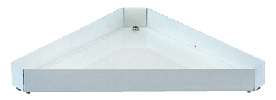 Accessory Tray
Accessory Tray
Model # AM-OO-3842
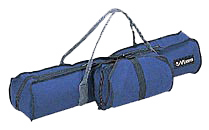
Model # AO-CC-2696
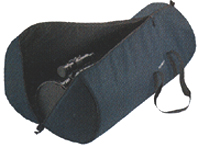
Contents Copyright 1994-2005 Company Seven All Rights Reserved



